Sterling Ruby gives us a tour of his sprawling LA studio
We tour Sterling Ruby’s 110,000 sq ft space, divided into distinct areas of operation, each focusing on an aspect of the American artist’s prodigious output
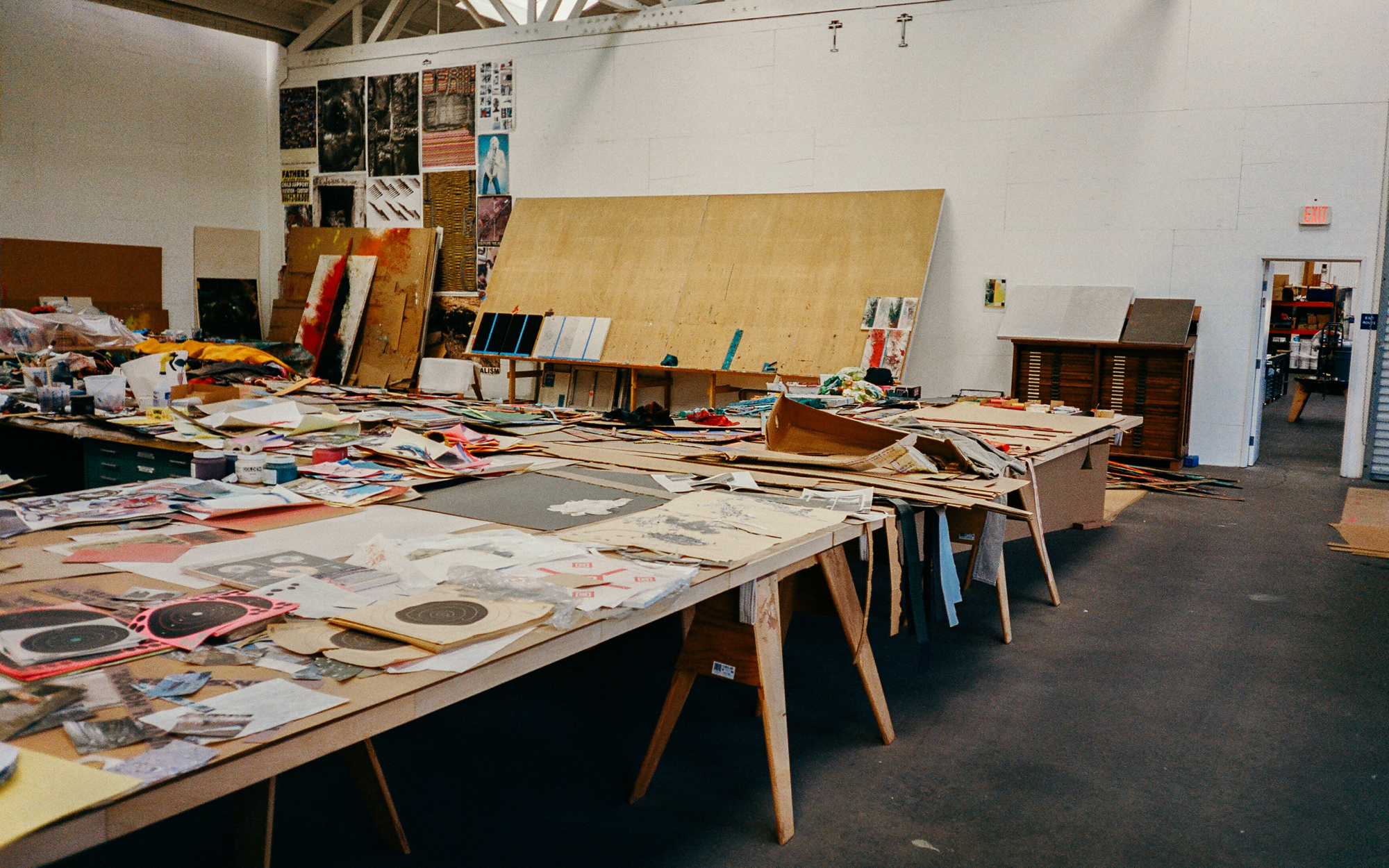
I’m not very idle,’ says Sterling Ruby as he walks through a studio that takes up much of a city block in Vernon, an industrial zone south of LA’s Arts District.
Wearing a Kelly green bandana and bespoke rubber work boots of his own design, Ruby conducts a tour led by his miniature Bernedoodle, Ruth, named in honour of the late US Supreme Court Justice Ruth Bader Ginsburg. A modest viewing room serves as an antechamber to a studio the size of a hangar, loosely divided into zones for each aspect of his unusually diverse art. Examples of his paintings, soft sculptures and other works are leaning against walls, lying on the floor or displayed on shelves. In a barrel-vaulted room, where light pours through skylights in the 39ft-high ceiling, half a dozen paintings are in the works for his upcoming show ‘Turbines’ at Gagosian New York (until 23 December 2022).
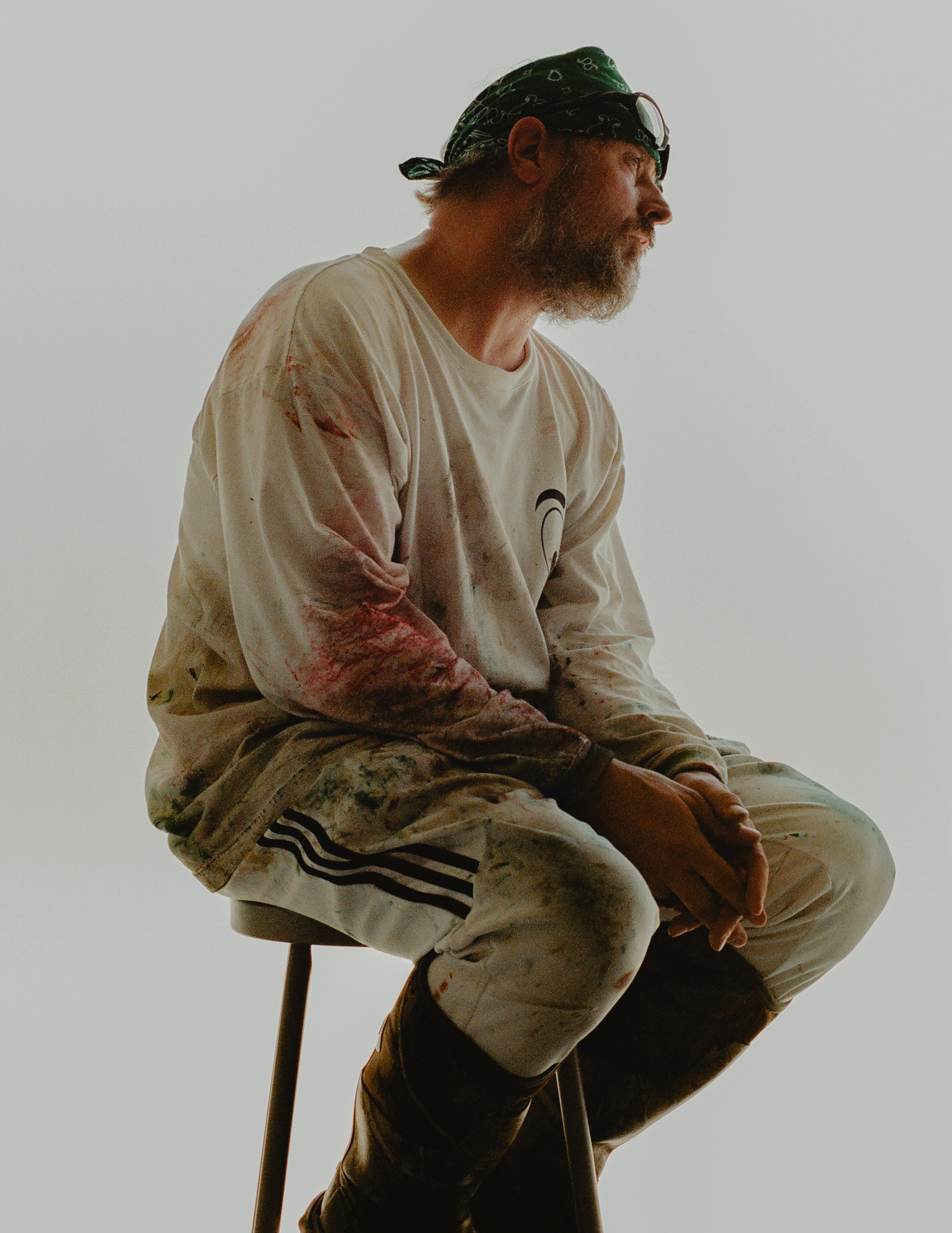
The artist wearing the paint-splattered clothes that have inspired some of the looks of his fashion label S R Studio LA CA
Narrow slats of cardboard are attached diagonally to canvases that have been over-dyed in colours including mustard and mint. The paint is applied by oil stick and brush, then manipulated by hand in sweeping angular gestures. Apart from help with hanging the heavy panels on the wall or laying them on the floor, he does the painting himself. ‘I like the materiality of collage in these. Everything is taken out of the studio, whether it’s the raw canvas, the scraps of cardboard that have been stepped on, or all the accumulation of paints.’
Though seemingly casual in execution, each vibrates with an interior tension. ‘I directly identify them in the lineage of constructivism,’ says Ruby, referring to the movement born in revolution-era Russia. ‘I like the way that both geometry and a painted mark can create depth in terms of the way things move in the painting. So much of what is happening now in art is didactically illustrative or static. I like taking from that period of history, which was so much about the disruption of shape, form and, of course, social revolution.’
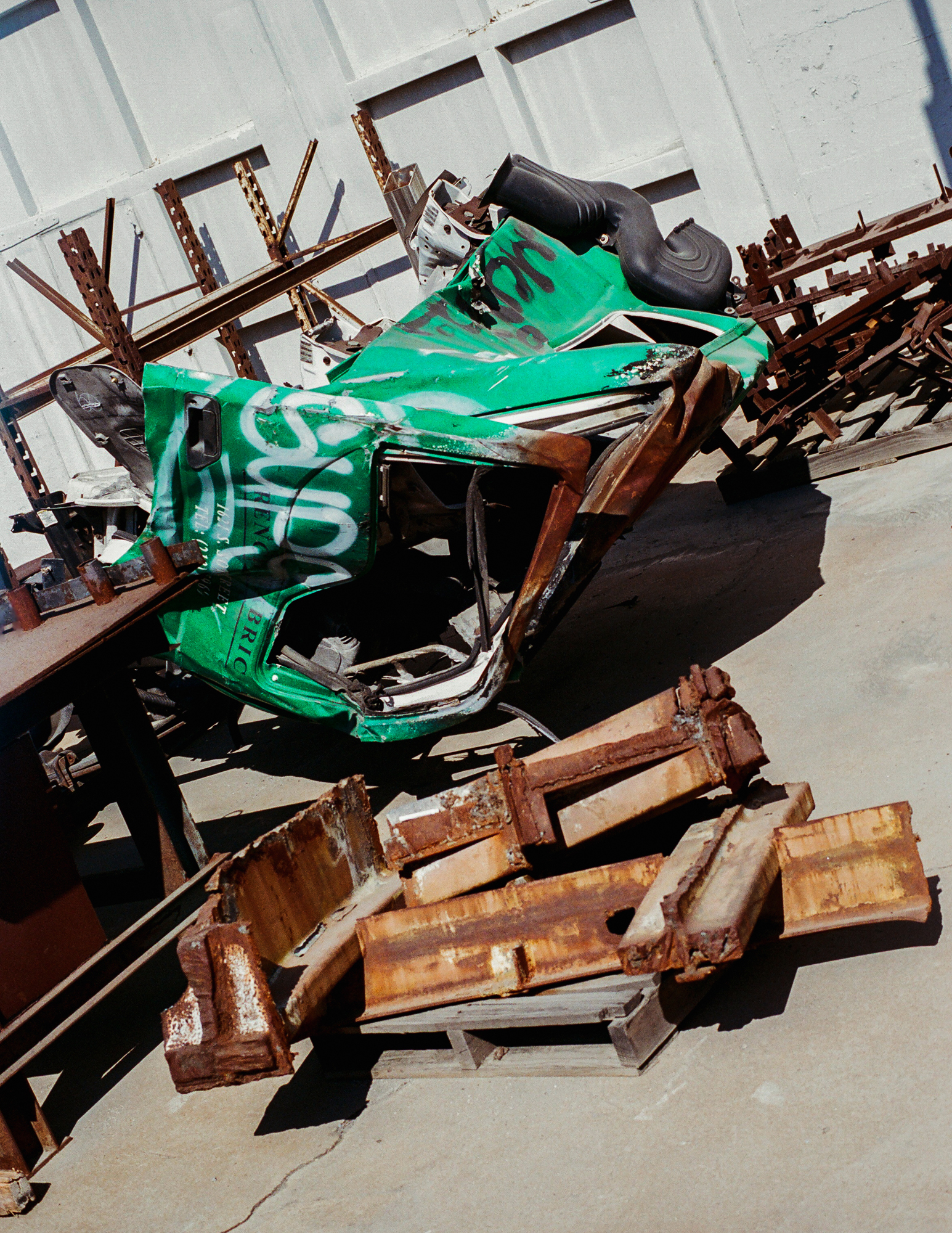
Scrap metal in the yard, which is part of a two-acre studio that also includes a 10,000 sq ft storage space for the artist’s archive
The turbine, a rotary machine that produces energy, is an accurate description of the art but also the artist. Ruby is infamous for powering through critical, commercial and institutional barriers by simultaneously working in ceramics, textiles, video, fashion, sculpture and, yes, painting.
His tumultuous first museum show ‘Supermax’, at LA’s Museum of Contemporary Art in 2008, obliquely referenced America’s for-profit prison system with pendulous sculptures that resembled red stalactites and spray-painted canvases. He joined and then left a number of top galleries, ultimately deciding on individual arrangements with a few, including multiple Gagosian venues. Artist Piero Golia observed in a 2016 interview for Kaleidoscope, ‘You’ve done it all wrong – which I mean in a positive way. It hasn’t mattered [...] – I think it’s because the poetics of the work completely validate this kind of production.’
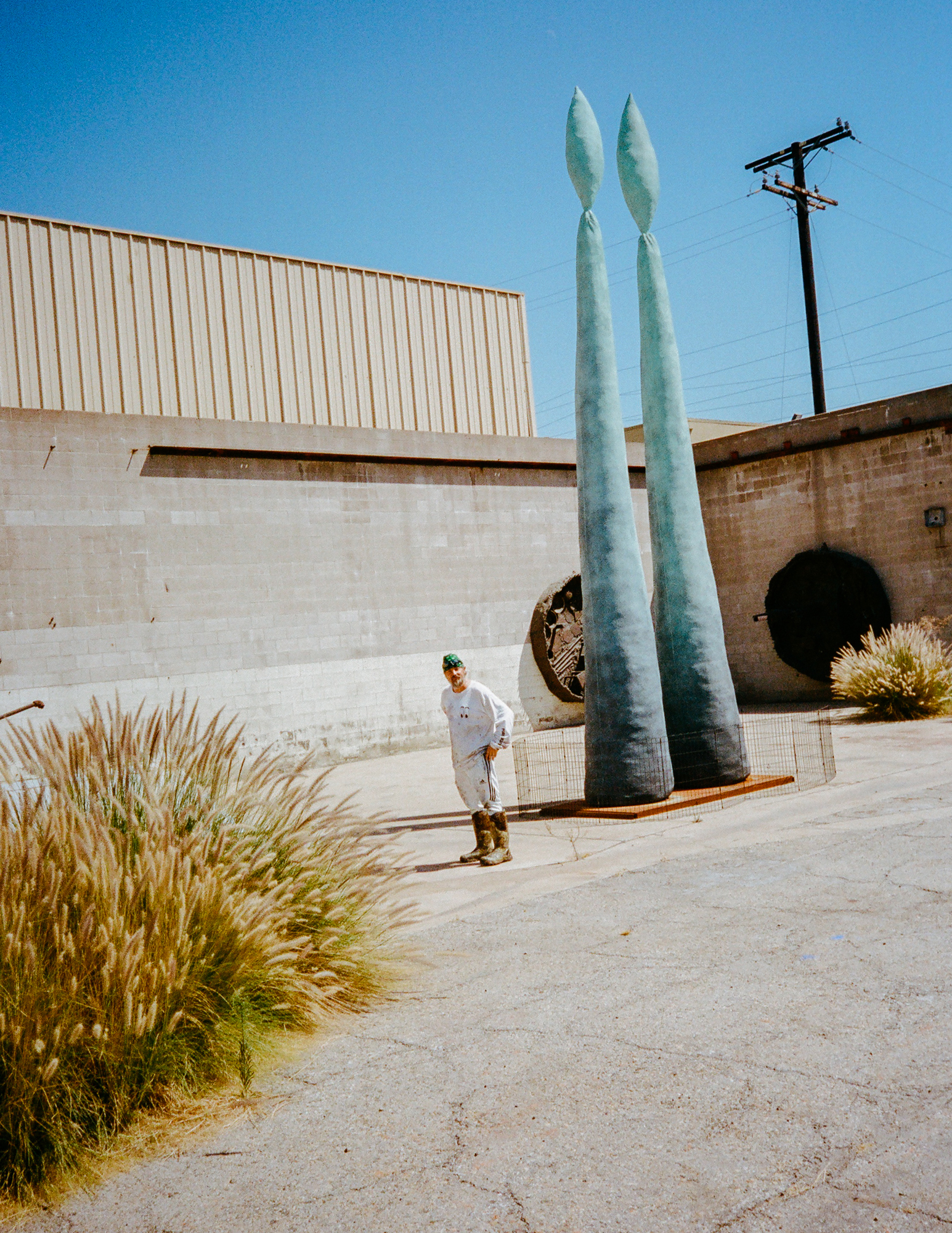
Sterling Ruby in his studio in Vernon, CA, with Double Candle (2018)
Initially, Ruby was identified as an inheritor of the abrasive methods of Mike Kelley. As a graduate student at Art Center College of Design in Pasadena, he was teaching assistant to Kelley, a defining figure in the LA art scene of the 1990s and central to ‘Helter Skelter’, the explosive 1993 exhibition organised by Paul Schimmel, then curator at MOCA. Kelley worked with any medium that suited a sophisticated intelligence belied by his allegiance to punk rock and graphic sexuality. Ruby was drawn to LA in part after seeing the catalogue of that show, and relating to what he has called the ‘pathologies’ of its participating artists – Kelley, Paul McCarthy, Raymond Pettibon and others.
Receive our daily digest of inspiration, escapism and design stories from around the world direct to your inbox.
Ruby, now a settled family man living in Mount Washington, a hilly neighbourhood in northeast LA popular with artists, slightly winces at being pegged to the extremes of that history, noting that his art just as likely evolved from his upbringing.
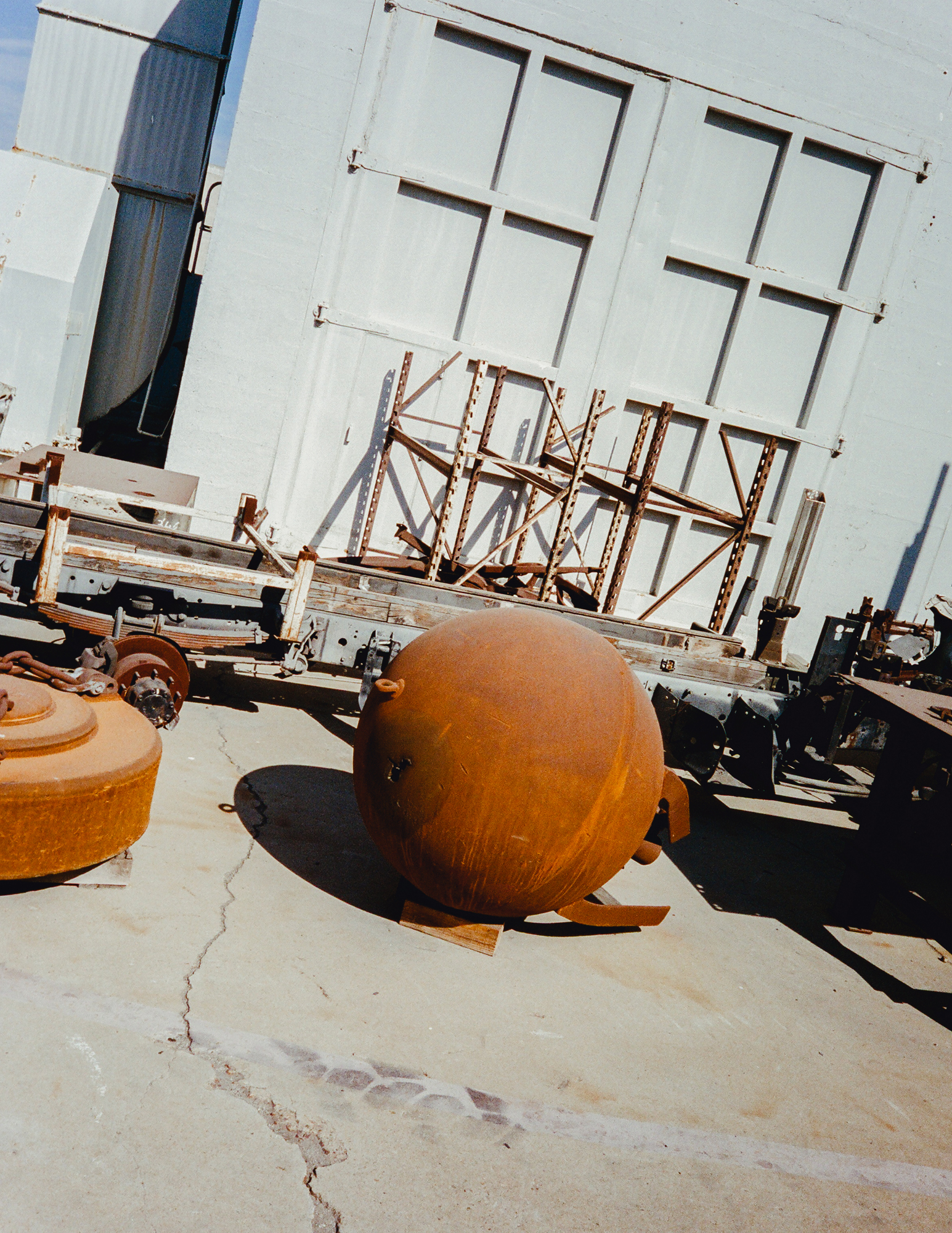
The yard is filled with metal pieces waiting to be turned into artworks
He was raised for the most part in New Freedom, a railroad town in an area of Pennsylvania traditionally farmed by the Amish. His fantastic first name was bestowed by parents with hippie inclinations, while Ruby is a family legacy. His American father met his Dutch mother while in the military and stationed in Europe. Both influenced the artist. His mother taught him to sew, and as a hobby glazed the family’s ceramic dishes. His father, who worked in demolitions, would bring his son to watch and even help.
‘I’m from a very blue-collar upbringing,’ explains Ruby. ‘I went to an agriculture school in Pennsylvania where everybody had to learn how to weld, to run a table saw and jig saw. Labour was always emphasised from an educational standpoint, but also from my father’s side of the family, which was just hardcore.’
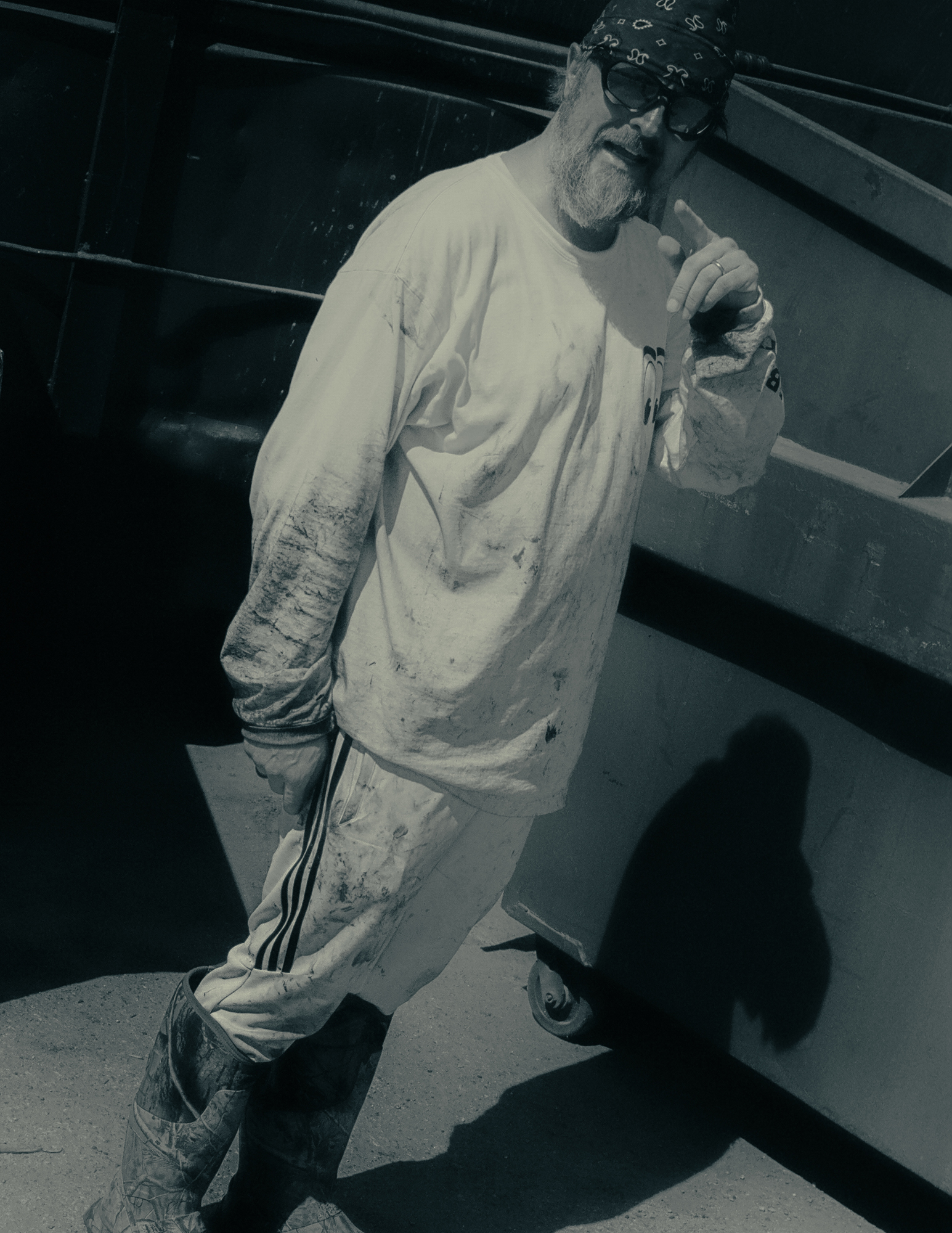
Ruby in his studio, wearing bespoke rubber work boots of his own design
Ruby was working in construction when he was accepted by what is now the Pennsylvania College of Art and Design in Lancaster. The emphasis was on realist art in the manner of Andrew Wyeth, who lived in the area. But it led him to Chicago, where he got a BFA in 2002 at the School of the Art Institute. He became friends with fellow student Aaron Curry. Both then moved to LA to study at Art Center, where the curriculum was laden with critical theory. After intensive reading of Derrida and more, he revolted: ‘I wanted the exact opposite. I wanted craft to be part of my work. I wanted textiles to be part of my work. I wanted clay to be part of it. All things that were not meant to be from that particular point of view.’
Ruby’s roots are apparent in the studio area that opens to the outdoors, cluttered with stacks of rusted scrap metal to be used in his sculpture. This brings up thoughts of another Pennsylvania artist: Alexander Calder. Ruby nods in agreement. ‘When I first started doing mobiles, I was looking at them as 3D free-floating collages. Of course, you can’t make a mobile without contending with the history of Calder.’
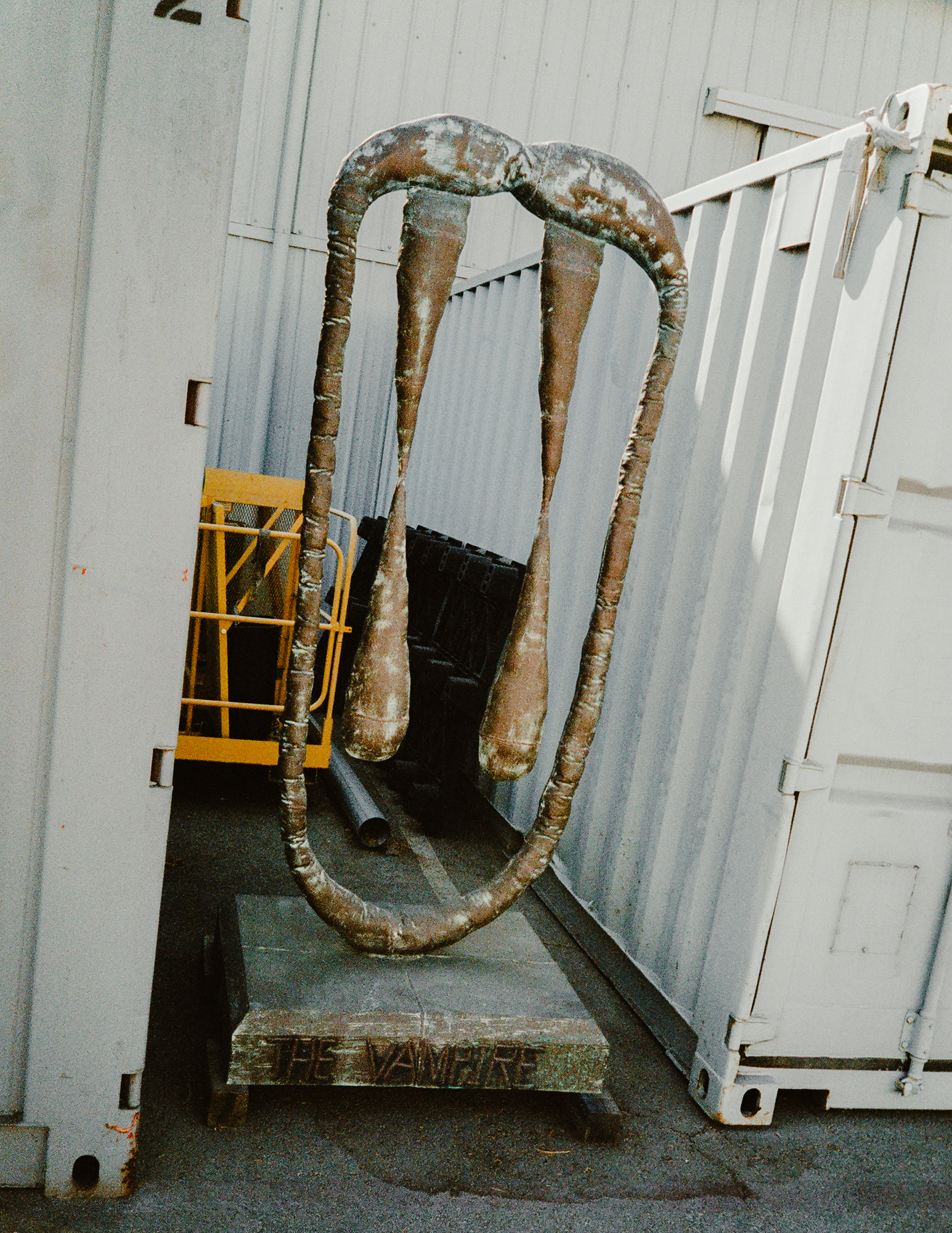
Ruby is known for his large-scale sculptures, such as The Vampire, 2012
In summer 2022, he completed the first part of ‘A Project in Four Acts’ on the exterior of a Venetian palazzo being renovated by billionaire collector Nicolas Berggruen. HEX is an attenuated mobile, a scrap metal frame supporting a large red circle and yellow fabric flag. Ruby recalls growing up in drab environs and the impact of vibrant hex signs painted on the weathered barns. He explains, ‘Hex signs in primary colours – yellows, reds, greens, blues – were used by farmers to protect the buildings and their dwellers. They were supposed to keep the property safe and prosperous during changing seasons. And so I decided to give Nicolas my own version of the hex sign.’
Ruby relies on notions of excavation in much of his work, which fits with the restoration of the 18th-century Palazzo Diedo. ‘Sterling’s work is dynamic, omnivorous,’ Berggruen commented by email. ‘It is very different from what is typically shown in Venice and may seem provocative to many. But why not? We want to bring together the classical and the contemporary, as well as different cultures and ways of thinking. What Sterling does is very American in this sense.’

Ruby’s 110,000 sq ft studio is organised into distinct areas of operation. He committed to this place in 2012, after visiting his wife, photographer Melanie Schiff, when she was in residency at Donald Judd’s studios in Marfa, Texas. ‘Prior to this, I was in open spaces where everything was being worked on together: a ceramic next to a work on paper or a painting next to a textile piece. When I moved in here, I decided to give myself a bit more clarity. Everything is compartmentalised,’ he explains. ‘It’s changed nothing in terms of how I make work, but it allows us to have more autonomy. There are very few things that we do outside of the studio. I like the idea that we’re representative of this kind of Bauhaus historic scenario of everything under one roof.’
The Bauhaus remark is telling. While many top artists have studios on this scale, Ruby aligns himself and his work with traditions of craft or modernist enterprise rather than the factory legacies of Warhol or Koons. The scale and substance of his handmade sculptures in clay or fabric remove them from what critics historically considered to be the realm of hobby. That also jibes with Ruby’s reputation as a rebel refusing to abide by the restrictions of fine art labels.
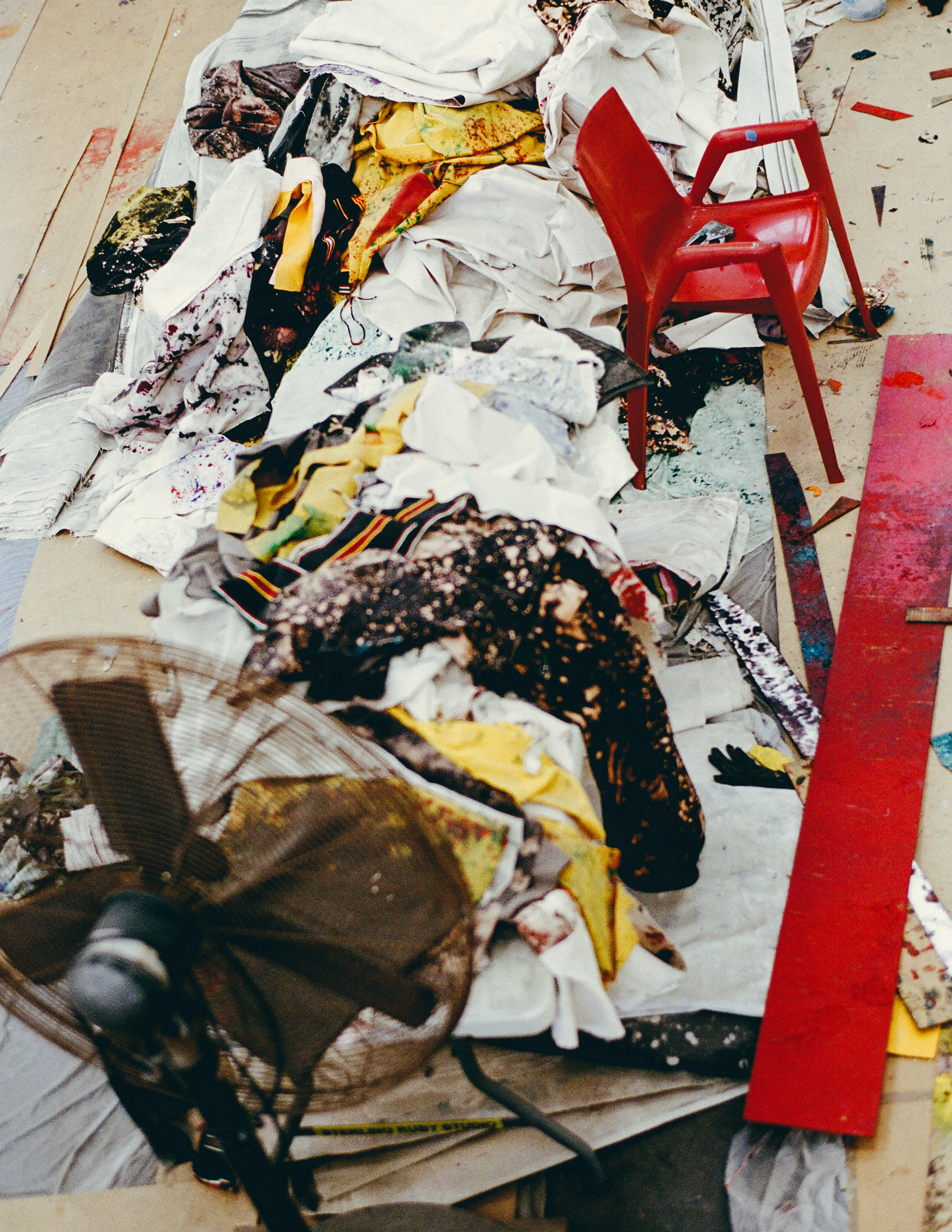
The textiles studio, where Ruby works on his soft sculptures and fashion label
In the ceramics rooms, three car kilns with runners facilitate moving his huge clay sculptures. ‘When we start firing, a ceramic reaches temperature in a week, and then we let it cool down for another week,’ says Ruby. ‘So each piece, when it’s at a certain size, fires at two-week intervals.’ A lumpen ceramic basin contains scraps of previous efforts glazed in acidic colours. Though rough in appearance, it is carefully conceived and, in a way, recalls his father’s occupation. ‘I was really into the idea of excavating, especially when one out of every three ceramics would blow up. I started to think, how can I incorporate all of these things? So the vessel itself is new, but everything that’s inside the vessel is from a past work that has not survived.’
The tour of the studio concludes at a huge pile of fabrics on the floor, the area dedicated to his soft sculpture and to his most controversial work: fashion. What started as garments for himself and friends, a remnant of his youthful hobby of sewing on his mother’s machine, became a high-profile collaboration in 2014 with designer Raf Simons. Some art critics and dealers thought it signalled a bow to commercial forces and questioned the sincerity of his art. Now Ruby is back to operating his privately owned fashion label, S R Studio LA CA, with a monochrome collection of surprisingly delicate ivory and white dresses with tiny pearl buttons.

From the outset, Ruby has refused to confine his efforts to a single medium. Each of his obsessions drives developments in others. As he told Golia, ‘My routine is to embrace my manic personality traits. I am making something over and over and over again, until it lapses into something else, or you see a variation on a theme.’ The turbine needs to keep moving. It’s time for lunch to discuss a music project for one of his video works.
As Ruby explained, he doesn’t like to be idle.
Sterling Ruby, 'Turbines' is on view from 10 November-23 December 2022 at Gagosian, 522 West 21st Street, New York, gagosian.com, srstudio.com
-
 A day in Ahmedabad – tour the Indian city’s captivating architecture
A day in Ahmedabad – tour the Indian city’s captivating architectureIndia’s Ahmedabad has a thriving architecture scene and a rich legacy; architect, writer and photographer Nipun Prabhakar shares his tips for the perfect tour
-
 You can now stay in one of Geoffrey Bawa’s most iconic urban designs
You can now stay in one of Geoffrey Bawa’s most iconic urban designsOnly true Bawa fans know about this intimate building, and it’s just opened as Colombo’s latest boutique hotel
-
 Pentagram’s identity for eVTOL brand Vertical Aerospace gives its future added lift
Pentagram’s identity for eVTOL brand Vertical Aerospace gives its future added liftAs Vertical Aerospace reveals Valo, a new air taxi for a faster, zero-emission future, the brand has turned to Pentagram to help shape its image for future customers